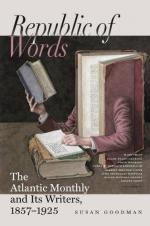VII.
Santa TRINITA.
In the chapel of the Sassetti, in this church, is a good set of frescos by Dominic Ghirlandaio, representing passages from the life of Saint Francis. They are not so masterly as his compositions in the Santa Maria Novella. Moreover, they are badly placed, badly lighted, and badly injured. They are in a northwestern corner, where light never comes that comes to all. The dramatic power and Flemish skill in portraiture of the man are, however, very visible, even in the darkness. No painter of his century approached him in animated grouping and powerful physiognomizing. Dignified, noble, powerful, and natural, he is the exact counterpart of Fra Angelico, among the Quattrocentisti. Two great, distinct systems,—the shallow, shrinking, timid, but rapturously devotional, piously sentimental school, of which Beato Angelico was facile princeps, painfully adventuring out of the close atmosphere of the miniatori into the broader light and more gairish colors of the actual, and falling back, hesitating and distrustful; and the hardy, healthy, audacious naturalists, wreaking strong and warm human emotions upon vigorous expression and confident attitude;—these two widely separated streams of Art, remote from each other in origin, and fed by various rills, in their course through the century, were to meet in one ocean at its close. This was then the fulness of perfection, the age of Angelo and Raphael, Leonardo and Correggio.
VIII.
San Marco.
Fra Beato Angelico, who was a brother of this Dominican house, has filled nearly the whole monastery with the works of his hand. Considering the date of his birth, 1387, and his conventual life, he was hardly less wonderful than his wonderful epoch. Here is the same convent, the same city; while instead merely of the works of Cimabue, Giotto, and Orgagna, there are masterpieces by all the painters who ever lived to study;—yet imagine the snuffy old monk who will show you about the edifice, or any of his brethren, coming out with a series of masterpieces! One might as well expect a new Savonarola, who was likewise a friar in this establishment, to preach against Pio Nono, and to get himself burned in the Piazza for his pains.




